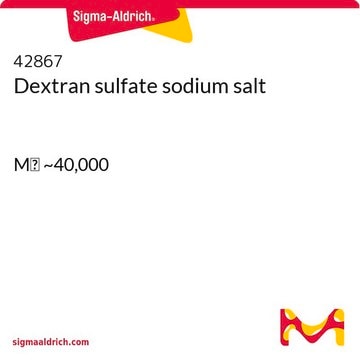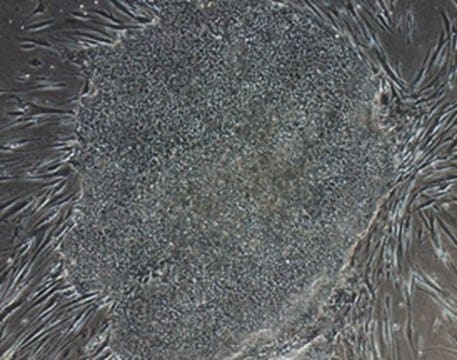We do not recommend including antibiotics during the formation of the transfection reagent/DNA complex. Increased cell permeability during transfection causes high antibiotic influx, resulting in cell death. Some antibiotics (such as kanamycin) are cationic and can therefore interfere with transfection. Antibiotics such as penicillin and streptomycin can be present in the complete growth media (with serum) which is used to grow the cells. If you are generating stable transfectants, add selection antibiotics (e.g., G 418 or hygromycin) 48-72h after transfection.
70967
Réactif de transfection GeneJuice®
Non-lipid based chemical transfection reagent optimized for maximum transfection efficiency, ease-of-use, and minimal cytotoxicity on a wide variety of mammalian cells.
Synonyme(s) :
Réactif de transfection, Transfection GeneJuice
About This Item
Produits recommandés
Niveau de qualité
Forme
liquid
Fabricant/nom de marque
Novagen®
Conditions de stockage
OK to freeze
Technique(s)
transfection: suitable
Conditions d'expédition
wet ice
Température de stockage
2-8°C
Description générale
Stuart Rulten. Chargé de recherche. Université du Sussex
« Depuis que nous utilisons GeneJuice, nous avons gagné beaucoup de temps et économisé beaucoup d′argent ! »
Dr Andrea Kress, Institut de virologie clinique et moléculaire, Erlangen, Allemagne
« Je trouve que GeneJuice fonctionne sur un grand nombre de types de cellules avec une optimisation minimale »
Caitriona Marie Lyons. Étudiante en doctorat. Université de Cork, Irlande
La transfection consiste à introduire des acides nucléiques dans des cellules de mammifères. Le Réactif de transfection GeneJuice est une formulation brevetée, optimisée pour garantir une efficacité de transfection maximale, une grande facilité d′utilisation et une cytotoxicité minimale pour les cellules de mammifères. Alors que beaucoup de réactifs de transfection disponibles sont basés sur des formulations de lipides cationiques, le Réactif de transfection GeneJuice® se compose d′une protéine cellulaire non toxique et d'une petite quantité de polyamine innovante. Le Réactif de transfection GeneJuice permet de transférer de manière extrêmement efficace de l′ADN lors de transfections stables et transitoires de cellules eucaryotes, et est idéal pour les transfections à haut débit sur des plaques multi-puits. Sa composition unique est compatible avec les milieux à base de sérum ainsi que les milieux sans sérum, ce qui permet de s′affranchir des changements de milieu durant les expériences de transfection. GeneJuice est une alternative performante aux diverses autres techniques, y compris la coprécipitation au phosphate de calcium, l′électroporation, la microinjection, l′administration biolistique de particules, la lipofection et la formation de complexes avec du DEAE-dextran. Le format de 1 ml fournit suffisamment de réactif pour effectuer jusqu′à 500 transfections sur des plaques de 35 mm.
Lignées cellulaires transfectées par le Réactif de transfection GeneJuice®
| Lignées cellulaires : | Cellules primaires : | ||||
|---|---|---|---|---|---|
| 10T1/2 293T 3T3 NIH 3T3 Swiss 3T3-L1 A204 A431 A549 alpha TC1-6 AR 42J As4.1 AtT-20 B50 BC-1 BC-2 BC3 BCBL BHK-21 C3H/10T1/2 C6 C2C12 | Caco-2 Caki-1 Calpan-1 Calu-1 Calu-6 CCL-131 CFPAC-1 Chang Foie CHO CHO-7 CHO-IR CHO-K1 COS-1 COS-7 CS-1 CV-1 Daudi DDTI MF-2 DT40 ECV304 EL4 | ES-E14TG2a EVSCC17M H9c2 HCT-116 HEK293 HeLa HeLa B HeLa T4 Hep 3B2.1-7 HepG2 Hepa 1-6 Ht-29 HTB-37 HTB-45 Huh-7 HUVEC IC21 IEC-6 JEG-3 Jurkat KB | L57-3-11 L-6 L-929 MA-10 McA-RH7777 MCF-7 MCF-10-2A MDCK Mélanocyte MG-63 Neuro 2A Neuroblastome NRK NT2/D1 OV-1063 OVCAR3 P4 P19 PC12 PA317 PAM212 | PS-1 R2C RAW 264.7 RBL-2H3 RMP-41 SAOS-2 SC-1 Schneider line2 SK-N-MC SK-N-SH SKOV3 STO SW-480 SW-837 T3M4 TM4 U937 UCD Vero | Cellules de muscle lisse aortique Astrocytes Angioblastes Chondrocytes Cellules chromaffines Cellules épithéliales : mammaires prostatiques trachéales Fibroblastes Kératinocytes |
Caractéristiques et avantages
- Transfert d'ADN extrêmement efficace, aussi bien avec des transfections stables que transitoires.
- Compatibilité avec les milieux à base de sérum ainsi que les milieux sans sérum.
- Protocole simple - pas besoin de changer de milieu.
- Idéal pour les transfections à haut débit sur des plaques multi-puits.
- Idéal pour la production de rétrovirus destinés à la transduction de lymphocytes T.
- Compatible avec un grand nombre de types de cellules avec une optimisation minimale.
- Efficacité de transfection supérieure et cytotoxicité inférieure par rapport aux réactifs d′autres fournisseurs.
- Possibilité d′effectuer jusqu′à 500 transfections sur des plaques de 35 mm avec le format de 1 ml.
Avertissement
Notes préparatoires
Autres remarques
Informations légales
Mention d'avertissement
Danger
Mentions de danger
Conseils de prudence
Classification des risques
Eye Irrit. 2 - Flam. Liq. 2
Code de la classe de stockage
3 - Flammable liquids
Classe de danger pour l'eau (WGK)
WGK 1
Point d'éclair (°F)
67.1 °F - Information taken from reference works and the literature.
Point d'éclair (°C)
19.5 °C - Information taken from reference works and the literature.
Certificats d'analyse (COA)
Recherchez un Certificats d'analyse (COA) en saisissant le numéro de lot du produit. Les numéros de lot figurent sur l'étiquette du produit après les mots "Lot" ou "Batch".
Déjà en possession de ce produit ?
Retrouvez la documentation relative aux produits que vous avez récemment achetés dans la Bibliothèque de documents.
Les clients ont également consulté
Contenu apparenté
Major technological advances have made the production of monoclonal antibodies quicker and more efficient. There are three established platforms for antibody discovery. We offer reagents for production of monoclonal antibody libraries using each of these techniques.
Des progrès technologiques majeurs ont permis d'accélérer et d'accroître l'efficacité de la production d'anticorps monoclonaux. Il existe trois plateformes établies pour la découverte d'anticorps. Nous proposons des réactifs pour la production de banques d'anticorps monoclonaux en ayant recours à chacune de ces techniques.
Des progrès technologiques majeurs ont permis d'accélérer et d'accroître l'efficacité de la production d'anticorps monoclonaux. Il existe trois plateformes établies pour la découverte d'anticorps. Nous proposons des réactifs pour la production de banques d'anticorps monoclonaux en ayant recours à chacune de ces techniques.
Major technological advances have made the production of monoclonal antibodies quicker and more efficient. There are three established platforms for antibody discovery. We offer reagents for production of monoclonal antibody libraries using each of these techniques.
-
Will antibiotics interfere with transfection?
1 answer-
Helpful?
-
-
Can the DNA transfection reagents be used for co-transfecting plasmids?
1 answer-
Yes. Multiple plasmids can be transfected into the cell at the same time. The key is to maintain the optimal ratio of total DNA (all plasmids). See the User Protocols for more information on the ratio of reagent to DNA.
Helpful?
-
-
Why do I need to perform optimization? How should I go about doing it?
1 answer-
Each cell type behaves differently, by carrying out an optimization, the best transfection condition for your particular cell type can be determined. In other words, you can avoid putting too much transfection reagent on your cells, which may cause unnecessary toxicity issue and waste of precious transfection reagent. Optimization is suggested for every new combination of cell type and plasmid. The most important parameters are cell density and ratio of transfection reagent to DNA. Start with the volume of the selected transfection reagent (1x) and plasmid amount (1x) as recommended in the User Protocol. If those conditions do not yield the desired results, an optimization experiment can be performed. In a 24-well plate, plate the same amount of cells in each well. Set up a gradient across the plate and add the appropriate volume of transfection reagent (0.5x, 1x, 1.5x, 2x, 2.5x and 3x). Set up a gradient down the plate and add the appropriate amount of plasmid (0.5x, 1x, 1.5x and 2x). With a reporter gene in the plasmid, the optimal condition can be easily determined.
Helpful?
-
-
What is the size limit for plasmid DNA?
1 answer-
Large plasmids in the range of 12-15 kb can be transfected. We have cloned and expressed inserts encoding large proteins (including β-gal) without difficulty in mammalian cell lines.
Helpful?
-
-
How do I scale my transfection protocol when working with different culture volumes?
1 answer-
For most standard culture formats, guidelines are provided in the User Protocol. If you are using different culture volumes, vary the amounts of DNA, transfection reagent, cells, and culture media in proportion to the relative surface area while keeping the transfection reagent: DNA ratio constant.
Helpful?
-
-
Is the quality of DNA important for good transfection?
1 answer-
Yes, it is essential that the DNA to be transfected is of high quality and free of endotoxins. Plasmid DNA preparations should include an endotoxin removal step.
Helpful?
-
-
Can I use the product in the presence of serum?
1 answer-
Yes. Our nucleic acid transfection reagents are effective for transfecting cells in media with or without serum. While cells can be incubated in media containing serum, it is absolutely critical that serum is NOT present during formation of the transfection reagent/DNA complex. For most applications, we recommend adding the transfection reagent/DNA complex (formed in serum-free media) to cells grown in complete growth media. For certain cell lines and experimental conditions, serum starvation of cells might be required. Since serum provides growth factors and nutrients, transfection efficiencies achieved with growth in serum containing media are typically better than those in serum-free media.
Helpful?
-
-
How long should I leave the transfection reagent on the cells? Do I need to change medium at any time after transfection?
1 answer-
Since our nucleic acid transfection reagents are compatible with serum-containing media, medium change after transfection is not necessary. The majority of cell types can be incubated with the transfection mix for 24-72h without any media change, and then harvested for the desired downstream application. If media change is necessary due to the toxicity of the protein being expressed, the transfection mixture can be removed after 2-8 h of incubation and replaced with complete growth medium.
Helpful?
-
Active Filters
Notre équipe de scientifiques dispose d'une expérience dans tous les secteurs de la recherche, notamment en sciences de la vie, science des matériaux, synthèse chimique, chromatographie, analyse et dans de nombreux autres domaines..
Contacter notre Service technique

















